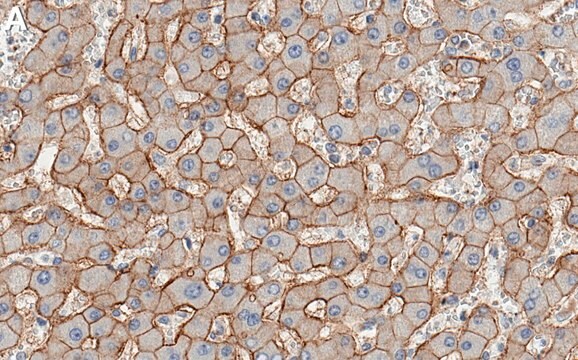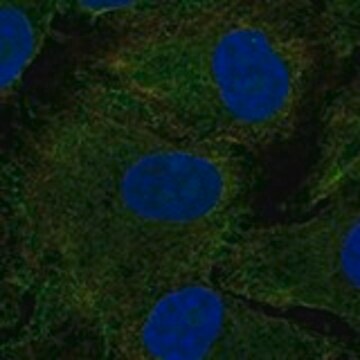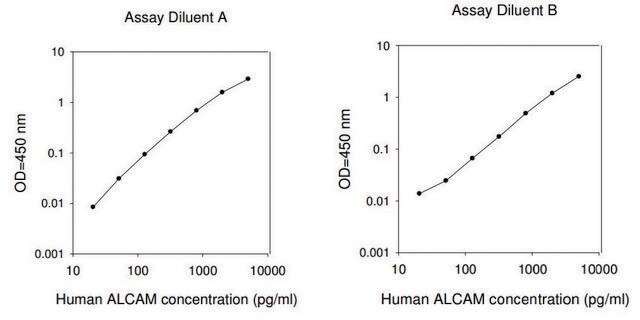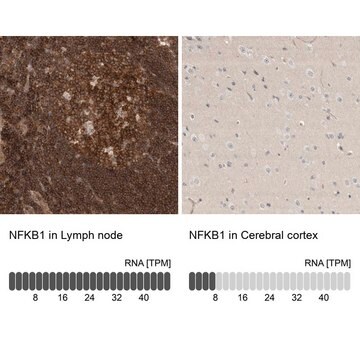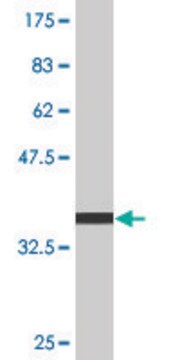MABN1785
Anti-CD166 (ALCAM) Antibody, clone TAG-1A3
clone TAG-1A3, from mouse
Synonym(e):
Activated leukocyte cell adhesion molecule, CD166 antigen
About This Item
Empfohlene Produkte
Biologische Quelle
mouse
Qualitätsniveau
Antikörperform
purified immunoglobulin
Antikörper-Produkttyp
primary antibodies
Klon
TAG-1A3, monoclonal
Speziesreaktivität
human
Verpackung
antibody small pack of 25 μL
Methode(n)
flow cytometry: suitable
immunocytochemistry: suitable
immunofluorescence: suitable
immunoprecipitation (IP): suitable
western blot: suitable
Isotyp
IgG1κ
NCBI-Hinterlegungsnummer
UniProt-Hinterlegungsnummer
Versandbedingung
ambient
Posttranslationale Modifikation Target
unmodified
Angaben zum Gen
human ... ALCAM(214)
Allgemeine Beschreibung
Spezifität
Immunogen
Anwendung
Neurowissenschaft
Immunocytochemistry Analysis: A representative lot detected CD166 (ALCAM) in Immunocytochmistry applications (Ding, Y., et. al. (2014). MAbs. 6(6):1439-52).
Immunoprecipitation Analysis: A representative lot detected CD166 (ALCAM) in Immunoprecipitation applications (Ding, Y., et. al. (2014). MAbs. 6(6):1439-52).
Flow Cytometry Analysis: A represetative lot detected CD166 (ALCAM) in human embryonic stem cells, human corneal stromal fibroblast (hCSF) cells, immortalized human corneal endothelial cells (B4G12), and human endothelial cells from donors (2) (Courtesy of Dr. Vanessa Ding, Ph.D. and Dr. Andre Choo, Ph.D, BTI, Singapore).
Immunofluorescence Analysis: A representative lot detected CD166 (ALCAM) in Immunofluorescence applications (Ding, Y., et. al. (2014). MAbs. 6(6):1439-52).
Western Blotting Analysis: A representative lot detected CD166 (ALCAM) in Western Blotting applications (Ding, Y., et. al. (2014). MAbs. 6(6):1439-52).
Qualität
Isotyping Analysis: The identity of this monoclonal antibody is confirmed by isotyping test to be human IgG1 .
Zielbeschreibung
Physikalische Form
Lagerung und Haltbarkeit
Sonstige Hinweise
Haftungsausschluss
Sie haben nicht das passende Produkt gefunden?
Probieren Sie unser Produkt-Auswahlhilfe. aus.
Lagerklassenschlüssel
12 - Non Combustible Liquids
WGK
WGK 1
Flammpunkt (°F)
Not applicable
Flammpunkt (°C)
Not applicable
Analysenzertifikate (COA)
Suchen Sie nach Analysenzertifikate (COA), indem Sie die Lot-/Chargennummer des Produkts eingeben. Lot- und Chargennummern sind auf dem Produktetikett hinter den Wörtern ‘Lot’ oder ‘Batch’ (Lot oder Charge) zu finden.
Besitzen Sie dieses Produkt bereits?
In der Dokumentenbibliothek finden Sie die Dokumentation zu den Produkten, die Sie kürzlich erworben haben.
Unser Team von Wissenschaftlern verfügt über Erfahrung in allen Forschungsbereichen einschließlich Life Science, Materialwissenschaften, chemischer Synthese, Chromatographie, Analytik und vielen mehr..
Setzen Sie sich mit dem technischen Dienst in Verbindung.